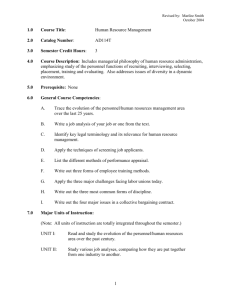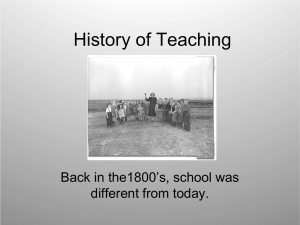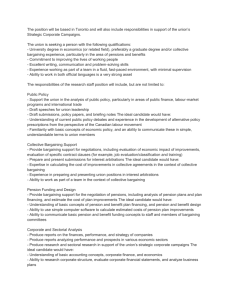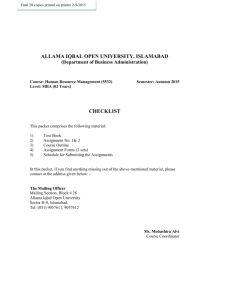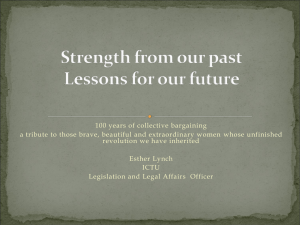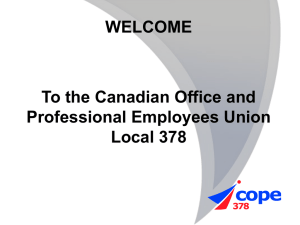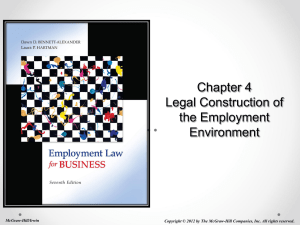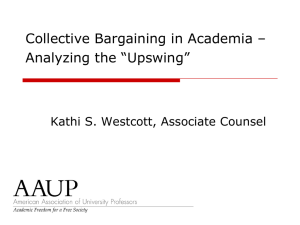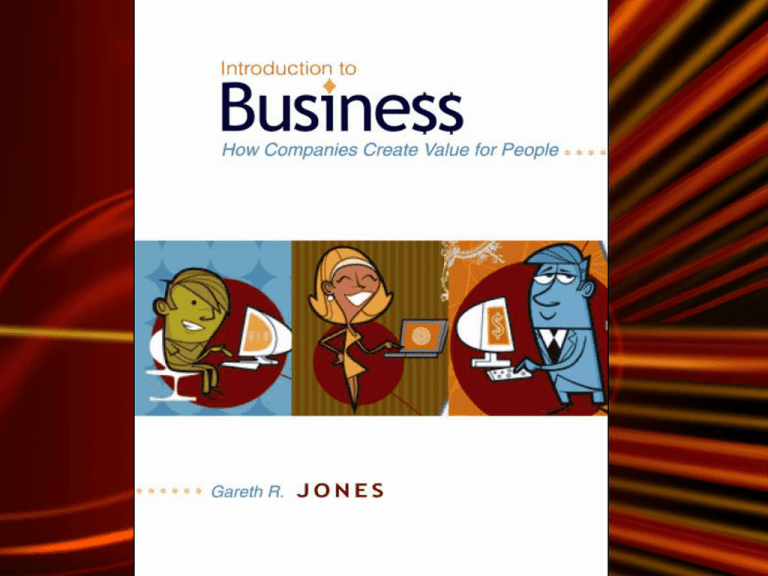
Chapter Thirteen
Human Resource
Management
McGraw-Hill/Irwin
Introduction to Business
© 2007 The McGraw-Hill Companies, Inc., All Rights Reserved.
Human Resource Management
(HRM) Systems
• Human resources – all the people that a
business employees
• Human resource management
- the set of activities designed to recruit highquality employees and then improve their
skills and capabilities
13 - 3
The Five Components of the
HRM System
Figure 13.1
13 - 4
Recruitment and Selection
• Recruitment - the process
of identifying and
attracting a pool of
qualified applicants
• Selection – involves
creating the set of criteria
that determines which job
applicants are the best
match for a particular job
13 - 5
External and Internal Recruitment
• Internal recruitment
- a policy of promoting employees who
already work for a company
• External recruitment
- a policy of filling advanced job positions
with applicants from outside the company
13 - 6
The Selection Process
Step 1: Screening applications and résumés
Step 2: Applicant testing and reference
checks
Step 3: The interview process
Step 4: Making the final selection
Sample interview questions
13 - 7
The Four Steps in the
Selection Process
Figure 13.3
13 - 8
The Interview Process
• Structured interview
- all applicants are asked a series of
standard questions
• Nondirective interviews
- questions are open ended to give
applicants ample opportunity to reveal
skills, abilities, strengths, and weaknesses
13 - 9
Types of Standardized Tests
Figure 13.4
13 - 10
Training and Development
• Training and Development
- the process through which companies
increase their employees’ work skills and
knowledge to improve their job
performance
13 - 11
Training-Needs Analysis
• Training-needs analysis
- a method of identifying the kinds of
employee training that will result in the
greatest performance gains
• Training gap
- a specific type training an employee needs
to acquire
13 - 12
Training-Needs Analysis
Figure 13.5
13 - 13
Types and Methods of Training and
Development
• On-the-job training
- training employees receive in the course of
doing their jobs
13 - 14
Methods of Training and
Development
Figure 13.6
13 - 15
The Components of a Human
Resource Management System
• Performance appraisal
- the task of accurately identifying
differences in the level and quality of work
employees do and providing them with
feedback that increases their performance
levels
13 - 16
Performance Appraisal and
Feedback
• Performance appraisal
- the process of evaluating the contributions
an employee has made toward a
company’s functional and corporate-wide
goals
• Performance feedback
- the communication of performance
appraisal information to employees to
influence their future performance levels
13 - 17
Performance Appraisal Methods
Managers can evaluate:
1) Results or outcomes of an employee’s
activities
2) Specific employee actions or behaviors
that produced those outcomes
13 - 18
Who Appraises Performance?
Figure 13.7
13 - 19
Who Appraises Performance?
• 360-degree performance appraisal
- the process of using multiple sources of
information to appraise an employee’s
performance
13 - 20
Giving Performance Feedback
• Formal appraisals
- appraisals conducted on a regular basis to
provide employees with ongoing
performance feedback
• Informal appraisals
- appraisals that take place as managers and
subordinates meet from time to time to
discuss important work issues
13 - 21
Pay and Benefits
• Pay
- the monetary rewards, such as wages,
bonuses, and salaries, associated with a
particular job
• Benefits
- the monetary rewards, such as paid health
care, life insurance, sick and vacation pay,
and pensions, employees receive because
they are a member of a company
13 - 22
Pay and Benefits
• Pay structure
- the relative pay and benefits received by
employees doing different types of jobs or
jobs at different levels in a company’s
hierarchy
• Pay level
- the average salary a company chooses to
pay its employees compared to other
companies in its industry
13 - 23
Types of Incentive Pay
• Incentive pay
- the extra rewards employees receive when
they achieve specific work goals
13 - 24
Individual Incentive Plans
• Piecework plans
- pay plans that link the pay employees
receive to the number of units of a product
an employee makes
• Commission systems
- pay plans that link the pay employees
receive to the amount of revenue they earn
by selling a company’s products
13 - 25
Individual Incentive Plans
• Merit pay
- a pay system that links superior
performance directly to higher permanent
rewards, such as a certain percentage
increase in salary
• Bonus pay
- a one-time reward employees receive for
accomplishing a specific goal
13 - 26
Group and Companywide
Reward Systems
• Profit sharing plans
- pay plans that reward employees on the
basis of the profit a company earns in a
particular period
• Employee stock ownership plan
- a plan that allows employees to buy a
company’s shares at below-market prices
13 - 27
Group and Companywide
Reward Systems
• Organization bonus systems
- the one-time rewards employees receive if
a company achieves cost savings, quality
increases, and so on, in a specified time
period
13 - 28
The Components of a Human
Resource Management System
• Labor relations
- the process of working with employees, or
the unions that represent them, to create
work rules and a negotiation process to
resolve disputes between them
13 - 29
Labor Relations
• Labor relations
- the process of establishing rules and
practices between a company and its
employees that specify how human
resources should be employed and
rewarded
13 - 30
Labor Relations
• Trade unions
- organizations that represent the interests of
employees who hold similar types of jobs in
a particular industry
13 - 31
Competition and Cooperation
among Stakeholders
Figure 13.8
13 - 32
Union-Management Relations
• Industrial conflict
- the clash that occurs when workers and
unions attempt to obtain a greater share of
a company’s profits at the expense of other
stakeholders
• Working-to-rule
- when workers perform their jobs exactly as
specified in their employment contracts but
do no more
13 - 33
Union-Management Relations
• Lockout
- when managers decide to shut down a
company’s operations until workers are
willing to accept the employment conditions
being offered to them
• Strike
- a situation that arises when workers refuse
to do their jobs in an attempt to bring the
work process to a halt
13 - 34
Collective Bargaining:
Resolving the Conflict
• Collective bargaining
- the process through which union
representatives and managers negotiate a
binding labor agreement over work-related
issues, such as pay, benefits, and
grievance procedures
13 - 35
Collective Bargaining:
Resolving the Conflict
• Integrative bargaining solution
- a “win-win” solution that allows both parties
to benefit from the labor contract agreed
upon
• Attitudinal structuring
- the attempt by negotiators on each side to
influence each other’s attitudes during the
bargaining process
13 - 36
Collective Bargaining:
Resolving the Conflict
• Grievance procedures
- labor-contract rules used to resolve labor
disputes between companies and their
employees
13 - 37
Collective Bargaining:
Resolving the Conflict
• Mediation
- a conflict resolution method that involves
the use of a neutral third party, or mediator,
to help labor and management resolve their
differences and reach an agreement
13 - 38
Collective Bargaining:
Resolving the Conflict
• Arbitration
- a conflict resolution method that involves
the use of a third party to negotiate and
impose a binding agreement on labor and
management
13 - 39
Human Resource Planning
• Human resource planning
- the process of forecasting the type and
number of employees a company will
require in the future to meet the objectives
of its business model
13 - 40
Human Resource Planning
• Job analysis
- the process of obtaining detailed
information about the tasks and
responsibilities involved in each job in a
company
13 - 41
Human Resource Planning
• Job description
- a list of the specific tasks, duties, and
responsibilities that make up a particular
job
• Job specifications
- a written list of the required skills, abilities,
and knowledge needed to do a particular
job
13 - 42
Technical Sales Representative
Figure 13.2
13 - 43

![Labor Management Relations [Opens in New Window]](http://s3.studylib.net/store/data/006750373_1-d299a6861c58d67d0e98709a44e4f857-300x300.png)
